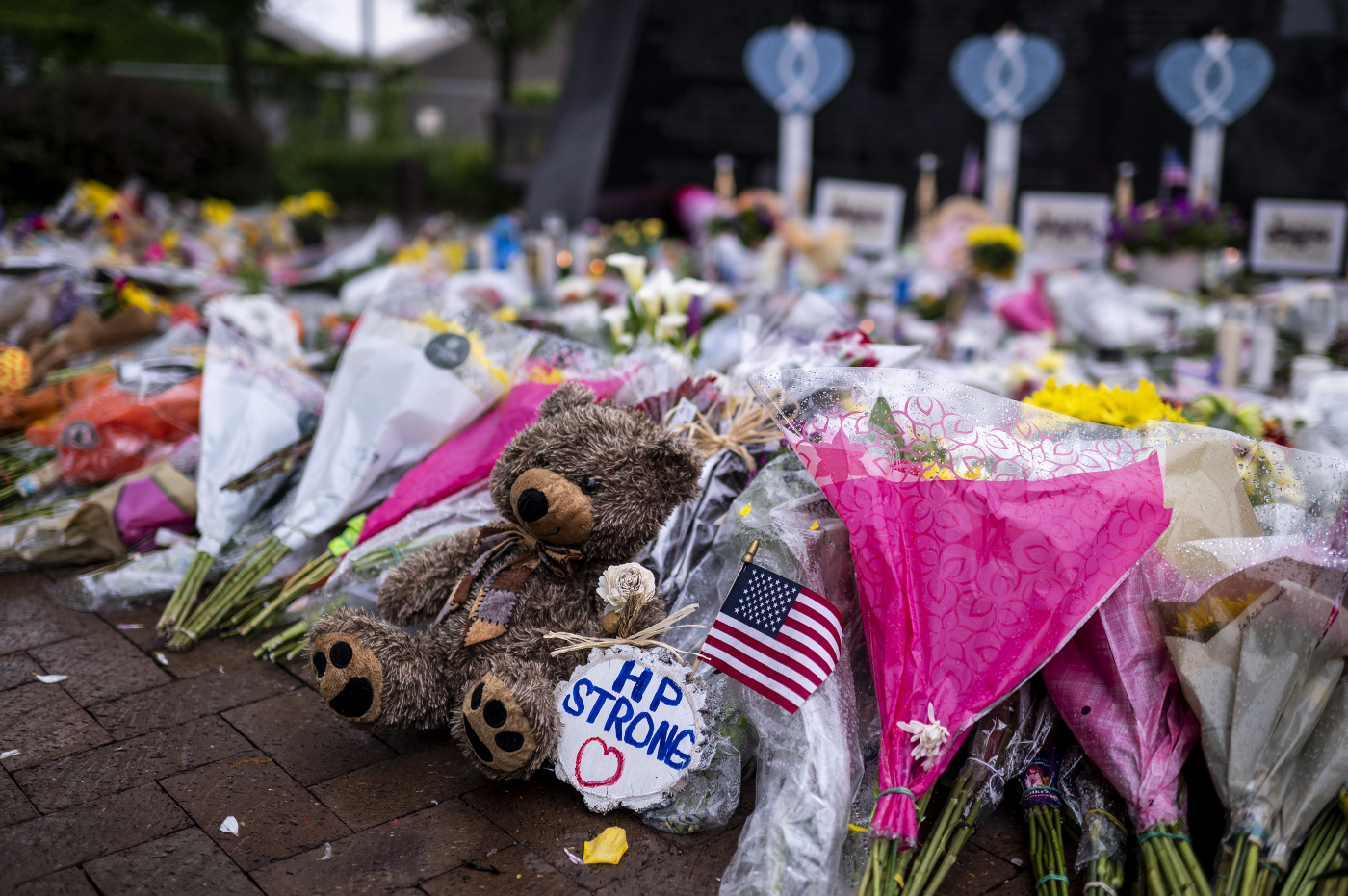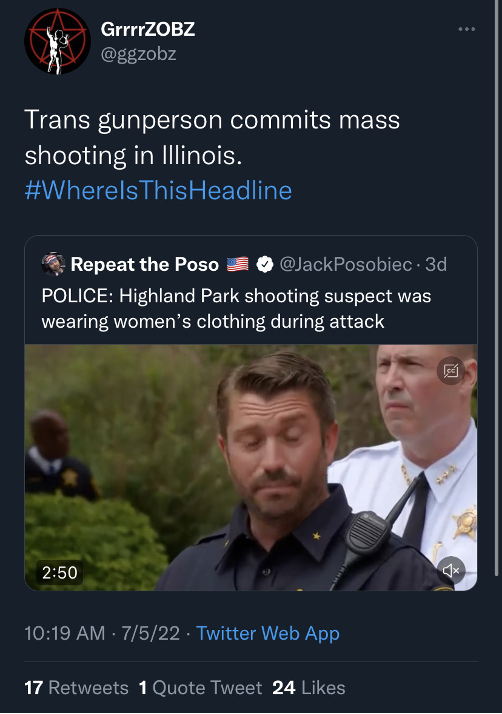Transphobic misinformation trends on Twitter after Highland Park shooting
Right-wing accounts spread harmful narratives associating transgender people with violent behavior and mental illness.
Transphobic misinformation trends on Twitter after Highland Park shooting

BANNER: A flag and painted placard reading “HP Strong” sits in front of a memorial to the victims of the July 4 mass shooting in Highland Park, IL on Friday July 8, 2022. (Reuters Connect/Christopher Dilts/Sipa USA)
In the aftermath of a mass shooting in Highland Park, Illinois during a July 4 US Independence Day parade, headlines circulated on Twitter reporting that the gunman wore women’s clothing as he opened fire into the crowd, killing more than half a dozen people. Amid heightened online attacks on trans individuals, right-wing social media accounts began to claim that the Highland Park shooter was a trans woman. However, investigators ultimately concluded that the gunman disguised himself with women’s clothing to draw attention away from his facial tattoos, and that there is no evidence to suggest that he is is trans.
The narrative after the Highland Park shooting follows a trend seen after the deadly shooting at an elementary school in Uvalde, Texas. Soon after the Uvalde shooting, several images of trans women spread online with the misleading claim that they were the shooter. One of the trans women whose pictures were shared alongside the claim defended herself on Reddit in the wake of the Uvalde shooting. Even after it was confirmed that the alleged shooter was cisgender, narratives surrounding the Uvalde shooter being a trans woman continued to spread on 4Chan.
Now, this fearmongering trend continues, as online accounts misrepresent the Highland Park shooter as a trans woman. In an attempt to justify transphobia, right-wing 4chan users spread the false narrative that being transgender caused the Highland Park shooter’s proclivity for violence and is at the root of his supposed mental illness. This type of disinformation can endanger innocent trans individuals, while simultaneously providing fodder for future attacks.

Transgender individuals have become the latest target of the far right as the ‘culture war’ plays out online. Hate groups have ramped up their targeting of trans people, calling them predators lurking in bathrooms, making claims about unfair advantages between children in sports leagues, and alleging that drag queens are corrupting children at the library. Now, transphobes are beginning to associate mass shooters with the trans community.
Tracking transphobic trends

The morning after the Highland Park shooting, news outlets published reports highlighting that gunman was spotted wearing women’s clothing at the time of the incident. Shortly after, the right-wing press picked up on the story to twist the narrative, emphasizing his female attire in their headlines. Then, right-wing influencer accounts amplified these titles early in the afternoon leading to the peak in engagement on keywords “trans,” “transgender,” and “trans woman” in connection with the Highland Park shooting at noon ET on July 5, 2022. These influencer profiles leveraged the rapidly developing news to steer conversations toward transphobic narratives. As soon as right-wing influencer accounts began sharing the news, their audiences jumped to a transphobic assumption based on the misleading headline that the suspect was a trans woman. During the peak, buzz began about a trans mass shooter in both right-wing and leftist spheres.
While engagement on the keywords reached nearly 6,000 mentions, the DFRLab cannot independently distinguish between bigoted posts and activist intervention within the aggregate data. Additionally, engagements do not necessarily mean endorsements, so a simple like or retweet cannot be conclusive without reviewing a person’s entire timeline. Moreover, most headlines did not explicitly state that the shooter was transgender; instead, the implication was made by right-wing influencer accounts that stressed the importance of the shooter’s clothing. Spurred by these influencer profiles, their audiences engaged in transphobic rhetoric via comments and quote tweets.
Far-right sources, such as the Daily Wire and Disclose.tv, published similar headlines focused on the shooter’s attire. The former emphasized “Dressed in Women’s Clothing” as a key point, while the latter included footage of police announcing that the shooter wore women’s clothing.

Right-wing influencer accounts subsequently proliferated these stories.

In response, other accounts questioned whether the shooter could be transgender or intersex.

Alt-right personality Jack Posobiec, for example, tweeted footage of police discussing preliminary findings and captioned the post, “POLICE: Highland Park shooting suspect was wearing women’s clothing during attack.”

Subsequently, accounts that follow Posobiec picked up on the transphobic insinuation.

The Right’s response versus the Left
As disinformation about the shooter’s gender went viral, accounts on both ends of the political spectrum agreed that the mass shooting was an act of political extremism, even though there was not definitive evidence to confirm this. An example of this can be seen in online responses to @Breaking911 tweet with the headline, “Highland Park Gunman Wore Women’s Clothing During Mass Shooting, Cops Say.” One individual responded with images of the alleged shooter at MAGA and Trump rallies. This left-leaning account interpreted the headline as transphobic, emphasizing that the headline was “fascist framing” and that the shooter was a “a man, a white man.” A right-leaning profile, meanwhile, claimed that a true Trump supporter would not engage in a mass shooting, especially on the Fourth of July.

At the time of publishing, it remains unknown whether the mass shooting was politically motivated.
Far-right turns to transphobic conspiracy
In the aftermath of the Highland Park shooting, speculation as to the shooter’s political affiliation ran rampant, with right-wing profiles unearthing photos previously posted to social media a pretext to foment increased transphobia, to attack Democratic politicians, and to push stereotypes of left-wing individuals.
For example, some right-wing commentary pointed to the shooter’s “effeminate appearance.” An image of him wearing pink pigtails composited with a smiling “I did that!” Biden sticker was shared on Twitter, with the claim that he was “clearly not MAGA affiliated.” A reposted Instagram story, meanwhile, mocked the shooter’s “feminine features,” including his pastel pink hair.

Another tweet pointed to his dyed hair and wardrobe. Notably, this tweet declared he was a socialist because of a supposed tattoo. Reuters later confirmed that the tattoo was of another individual and had nothing to do with the shooter.

Despite the Reuters report, as well as other reporting confirming the tattoo photo was of a different individual, an onslaught of transphobia persisted in the Twitter thread.

To right-wing transphobes, the shooter committed mass violence as a result of mental instability they correlated with his supposed effeminate appearance, despite the fact that the shooter identifies as a cisgender male and not a trans woman. By normalizing a specious connection between trans individuals and mass shooters, the far right continues fighting their culture war against the trans community. In doing so, trans individuals are put at heightened risk of assault by narratives falsely linking them to violent behavior. Similar correlations between being mentally ill, trans, and a mass shooter spread online after the Uvalde shooter was misidentified as a trans woman. This parallel between Highland Park and Uvalde signals an emerging and concerning trend of transphobia as a reaction to mass shootings.
After an influx of transphobic rhetoric following the Uvalde shooting, transgender activists were appalled, knowing that transphobic clickbait could result in real harm in the trans community should the talking point become standard. Historically, people justify discriminatory policies and extrajudicial violence by attributing violent associations to marginalized communities. When these narratives circulate, online hate can turn to offline harm. In the aftermath of Uvalde, trans women were subjected to bigoted cyberbullying by transphobes and were treated as scapegoats for the shooting. Fearful, these women worried about their physical safety offline. Now, with Highland Park, the demonization of trans individuals continues in alt-right spheres.
Cite this case study:
Madeleine MacWilliamson, “Transphobic misinformation trends on Twitter after Highland Park shooting,” Digital Forensic Research Lab (DFRLab), July 14, 2022, https://medium.com/dfrlab/transphobic-misinformation-trends-on-twitter-after-highland-park-shooting-e8071093ee54.

